The video shows the simulated charging processes of (private) e-vehicles over the course of a week in the Stuttgart region.
(Modell "eVerkehrsraum Stuttgart" - Projekt 2013-2015)

The agent-based simulation in mobiTopp takes into account, among other things:
| Consistent behavior of people and households throughout the week | .svg) |
Changes in the choice of activities due to e.g. expansion of home office |  |
| Availability and use of private and shared vehicles as well as their engine types and charging infrastructure for electric cars |
|
Vehicle-specific assignment of ridepooling and public transport |  |
| Integration of numerous influences on mobility behavior in the form of behavioral parameters |  |
Differences between times of day and days of the week |  |
| Spatial influencing factors such as accessibility | .svg) |
Aspects of the stability of mobility behavior such as transport preferences or social networks |  |
| Intermodal travel behavior within a route |  |
Logistics in the form of private, commercial and service provider agents |  |
Ridepooling is a modern approach to improving transportation services. This involves linking the travel needs of different people in a suitable way so that people can be mobile while at the same time reducing traffic. Depending on the precise objective of the respective project, this can provide good public transport coverage in sparsely populated areas and at off-peak times or provide convenient mobility that also causes little traffic. mobiTopp can map ridepooling using various methods. It is possible to calculate various scenarios that simulate ridepooling with different parameters.
In the MOIA accompanying research project, a mobiTopp model of the greater Hamburg area was set up. This was used to determine the effects of the MOIA ridepooling service provider. The simulation was carried out in a combination of mobiTopp together with the fleet simulation program FleetPy (live coupling of the two frameworks). The results show that higher penetration rates are accompanied by an increase in pooling.
The RABus project (real-world laboratory for automated bus operation in urban and rural public transport) simulates the use of ride pooling in the form of autonomous minibuses. Scenarios are calculated using mobiTopp models from Mannheim and Friedrichshafen, which differ in terms of operating times, service areas and vehicle sizes. The autonomous minibuses are considered both as the main modes of transport, and as a feeder to and from other means of public transport.
As part of two research projects, the mobiTopp simulation framework was expanded to include the logiTopp logistics module, which can be used to model the delivery traffic of parcel shipments over the first/last mile. Three new classes of acting agents have been integrated for this purpose: Delivery agents who carry out delivery journeys, the associated CEP service providers (CEP: courier express parcel) and companies as commercial, receiving agents. The combination of private, commercial and service provider agents enables interactions between private transport demand and logistics traffic, such as a detailed mapping of delivery processes by taking neighbors or opening hours into account. This simulation framework can be used to evaluate the impact of new logistics concepts on transport demand.
In the project "Profilregion Mobilitätssysteme Karlsruhe - TP3: Urbane Mobilität im Wandel - AP3: City Logistik und Wirkungen auf den Personenverkehr" (2019-2021), solutions were developed that can be used to make delivery traffic more sustainable. Among other things, additional traffic caused by non-deliverable goods was quantified and their impact on emissions analyzed. Developments in the e-commerce sector (such as the effects of the COVID-19 pandemic) and the potential of micromobility and electrification in city logistics were also examined.
For the project "LogIKTram - logistics concept and ICT platform for light rail-based freight transport" (2021-2024), companies were integrated as commercial customers of the CEP service providers, which can both receive and send parcels. In addition to the fundamental expansion of the logiTopp logistics extension, the LogIKTram project is investigating scenarios for the introduction of light rail-based freight transport in urban and regional transport with efficient handling and transport processes. To this end, new models and algorithms are being developed and integrated into the framework in order to map the parcel demand of companies, their contractual relationships with CEP service providers and the route planning for transport chains consisting of several modes of transport.
Initial results show that a cargo tram can generally be expected to have a positive effect on traffic. However, the potential depends heavily on various factors such as the number and location of city hubs.
The increasing networking of different mobility services, such as local public transport, car and bike sharing or ridepooling on a multi- and intermodal level offers opportunities to make future mobility more sustainable. Multimodality refers to the use of different means of transport over a certain period of time (e.g. a week) and intermodality to the use of several means of transport on one journey. Both the improved availability of combined offers and the individual new partial offers change people's transport behavior to a certain extent. For effective planning of such services, it may be necessary to evaluate the effectiveness of multi- and intermodal transport services in models.
mobiTopp has the ability to map multi- and intermodal travel behavior. In addition to the consideration of all modes of transport and corresponding individual preferences, the mapping of partial stages of journeys is fundamental to this analysis. The decision on the mode of transport combination is made in several steps, whereby the main mode of transport is selected first and then the subordinate modes of transport can be added flexibly. All framework conditions such as service quality and availability are taken into account.
In the regiomove project, an intermodal and multimodal transport model was created for the Karlsruhe region. The model is used to evaluate the local mobility network resulting from a growing number of services. In various scenarios, combinations of mobility stations, which differ in terms of location and available means of transport, were integrated into the model and evaluated using the intermodal demand generated. This makes it possible to map each mode of transport in a suitable environment and associated distances in order to contribute to an intelligent and sustainable choice of transport and to design services according to needs.
The microscopic representation of vehicles as agents enables the detailed investigation of the energy consumption of cars. In the context of battery electric vehicles, this also makes it possible to model the decision of when and where to charge. Together with the microscopic view of public, publicly accessible and private charging infrastructure, charging processes can be analyzed in detail.
In the eNetze project, the effects of the targeted decarbonization of energy and transport systems over the next three decades were investigated for real, urban residential areas on the load on the low-voltage grid islands. Traffic in the Stuttgart region is modeled to estimate the energy demand due to increasing electromobility and its spatial and temporal distribution. These results show that no overloads are to be expected in the short term. For the year 2050, however, it can be shown that congestion is to be expected in all grid islands considered in all scenarios examined without grid expansion. However, the main cause of the increasing load on the electricity grids can be attributed primarily to the increased use of heat pumps in an electrified heating system.
The video shows the simulated charging processes of (private) e-vehicles over the course of a week in the Stuttgart region.
(Modell "eVerkehrsraum Stuttgart" - Projekt 2013-2015)